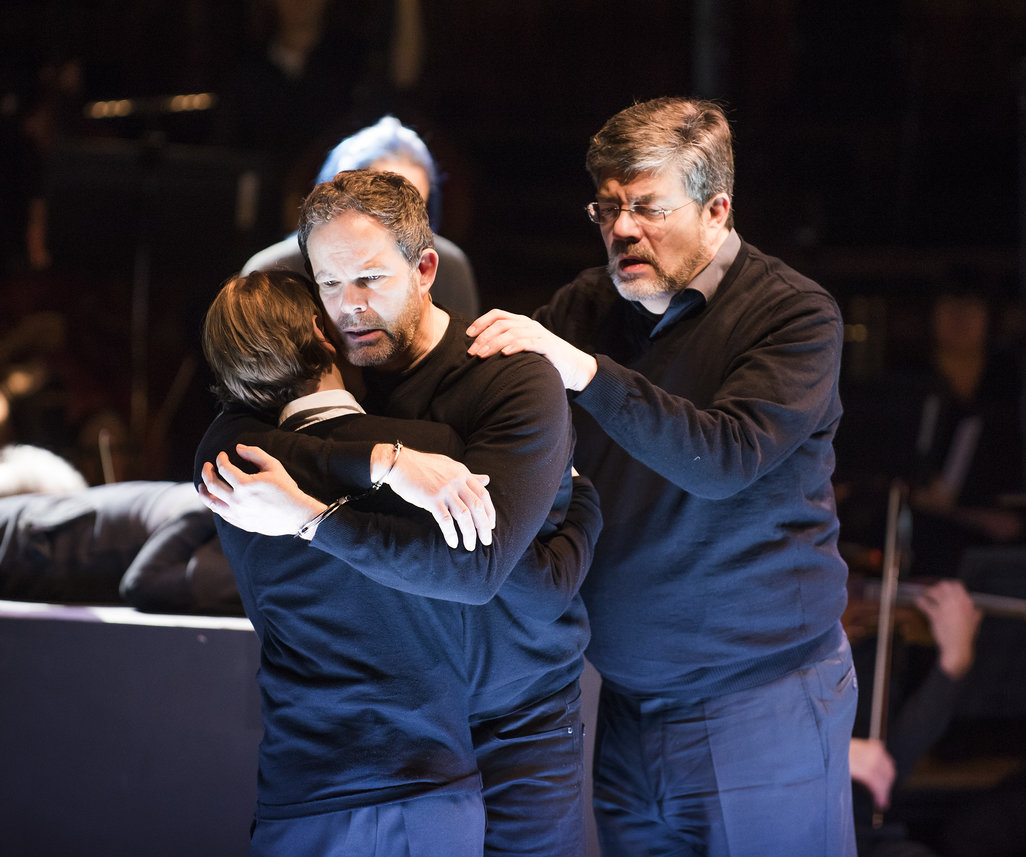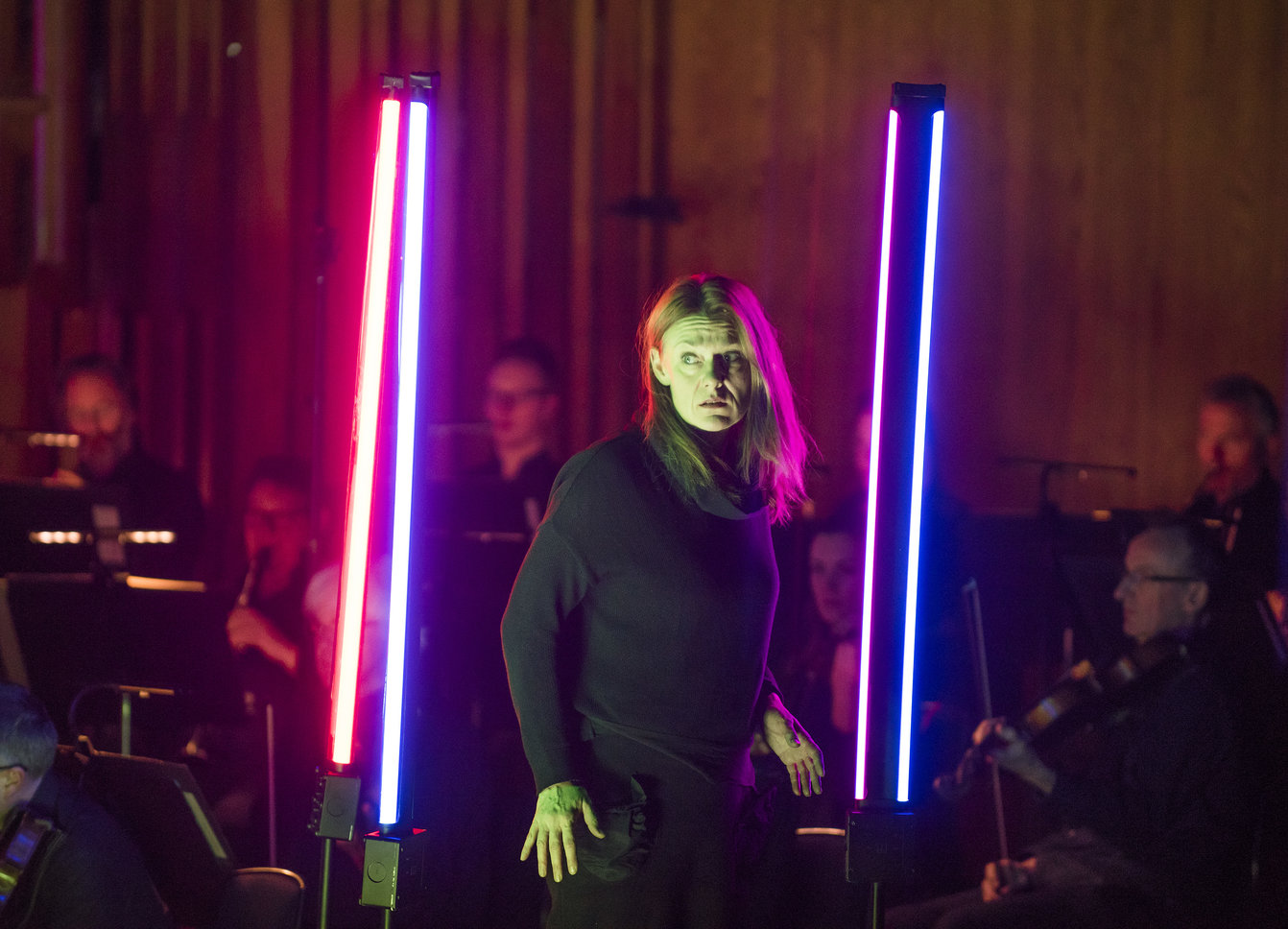Pelléas et Mélisande, LSO, Rattle, Barbican | reviews, news & interviews
Pelléas et Mélisande, LSO, Rattle, Barbican
Pelléas et Mélisande, LSO, Rattle, Barbican
A stripped-back staging marks a starry return for Rattle and Sellars

Debussy’s Pelléas et Mélisande is a drama played out in shadow. Shine too bright, too unyielding a directorial light on it, and the delicate dramatic fabric – all unspokens and unspeakables – frays into air. Just over a year ago, director David Edwards and the Philharmonia Orchestra gave us a semi-staging of exquisitely allusive simplicity, leaving the music to fill the gaps between symbol and emotion.
And what a difference a decade (or two) makes. Where Rattle and Sellars’s Amsterdam Pelléas played out in a Malibu mansion, sexual rather than sensual – a realist put-down to the opera’s whimsical fairytale history – their new collaboration shares more with Sellars’s “ritualisations” of Bach’s Passions than his work for the opera house.
It’s storytelling of the most instinctive kind, its text picked out in gilded details
At the centre of it all, both musically and spatially, are the LSO. Fanning out across the entire width of the Barbican’s stage, they cradle the drama taking place amongst them. With violas and second violins taking the outer positions, closest to the audience, their hold is a deliberately soft one, cushioning the sharper, brighter, more pointed contributions of harp, oboe and first violins, and creating the finest of musical membranes around the sound.
Rattle’s relationship with this score is a long one, and it unfolds here in spontaneous, giddy arcs of acceleration that shudder into eddying pauses. It’s storytelling of the most instinctive kind, its text picked out in gilded detail by the musicians of the LSO. There’s a delicacy here, even to moments of extreme violence, that seems the musical echo of Sellars’s staging – a series of suggestions, implications, possibilities that rarely coalesces into anything approaching a statement.
 Maeterlinck’s symbols – a tower, a cave, a lost ring – all retain their ambiguity, and only with his flock of sheep does Sellars slip into easy political assertion, as their “identity cards” are checked by a mobile-phone-clutching border-guard of a shepherd. Props are minimal. A black box placed centre-stage serves as tower, forest pool, bed and deathbed, allowing Mélisande to die among the violins, as the composer intended. At the back of the stage, a single chair allows Arkel to watch over the action, both threat and protector.
Maeterlinck’s symbols – a tower, a cave, a lost ring – all retain their ambiguity, and only with his flock of sheep does Sellars slip into easy political assertion, as their “identity cards” are checked by a mobile-phone-clutching border-guard of a shepherd. Props are minimal. A black box placed centre-stage serves as tower, forest pool, bed and deathbed, allowing Mélisande to die among the violins, as the composer intended. At the back of the stage, a single chair allows Arkel to watch over the action, both threat and protector.
What’s most striking is the reaction of a director whose language is physical symbol, ordered, ritualised gesture, to a drama whose own symbols are already so clearly defined. Aided by an exceptional cast, Sellars’s style softens into a stylised naturalism, finding the human as well as the humane in the story. Even with the clutter of a symphony orchestra on stage, you’re always aware of Gerald Finley’s Golaud (pictured above with Elias Madler and Franz-Josef Selig). His hunting doesn’t stop at the end of the opening scene, but continues throughout as he stalks and prowls, dangerously obsessed with Magdalena Kožená’s Mélisande. This confusion of tenderness and violence is mirrored vocally. Such patrician smoothness and control, such tonal beauty becomes grotesque when allied to the bullying of his son (the astonishingly mature Elias Madler) or his physical abuse of his wife.
Nobody takes a vocal line for a walk quite like Christian Gerhaher, whose Pelléas is one unfolding legato gesture, a halo of bright harmonics brightening his baritone for this high-lying role. Together with Finley, however, and both the magnificent Franz-Josef Selig as Arkel and Kožená’s mezzo heroine, he pushes the musical centre of gravity down into a darker place. No vocal light makes it into this Allemonde.
 There’s no denying that Mélisande is a role that suits Kožená (pictured left), making sense of the singer’s nervy series of performing ticks and sitting in a comfortable place vocally for this soprano-ish mezzo, but whether Kožená is the right performer for the role is less certain. Her Mélisande is no innocent. Instead of Maeterlinck’s vulnerable child we get a womanly seductress, fully in command of her two lovers. Compared to the interiority of Finley’s performance Kožená’s is positively cartoonish. Only the suggestion of real mental instability, that her Mélisande is aping a sexuality she has seen and learned, playing a role as best she can, saves the situation.
There’s no denying that Mélisande is a role that suits Kožená (pictured left), making sense of the singer’s nervy series of performing ticks and sitting in a comfortable place vocally for this soprano-ish mezzo, but whether Kožená is the right performer for the role is less certain. Her Mélisande is no innocent. Instead of Maeterlinck’s vulnerable child we get a womanly seductress, fully in command of her two lovers. Compared to the interiority of Finley’s performance Kožená’s is positively cartoonish. Only the suggestion of real mental instability, that her Mélisande is aping a sexuality she has seen and learned, playing a role as best she can, saves the situation.
Sellars has described Pelléas as “the ultimate non-operatic opera – opera as real life”. But watching his characters move through a stylised lightsaber forest, loving and hating among the musicians of the LSO, what he has created is real-life as opera. There’s no banality here, no anchor in the everyday, just pure emotion and psychology elevated and intensified by so casual a staging. Its home may be the concert-hall, but Debussy’s work has rarely been more richly or satisfyingly operatic.
- A final performance of Pelléas et Mélisande takes place on 10 January
rating
Share this article
The future of Arts Journalism
You can stop theartsdesk.com closing!
We urgently need financing to survive. Our fundraising drive has thus far raised £49,000 but we need to reach £100,000 or we will be forced to close. Please contribute here: https://gofund.me/c3f6033d
And if you can forward this information to anyone who might assist, we’d be grateful.

Subscribe to theartsdesk.com
Thank you for continuing to read our work on theartsdesk.com. For unlimited access to every article in its entirety, including our archive of more than 15,000 pieces, we're asking for £5 per month or £40 per year. We feel it's a very good deal, and hope you do too.
To take a subscription now simply click here.
And if you're looking for that extra gift for a friend or family member, why not treat them to a theartsdesk.com gift subscription?
more Opera
 Albert Herring, English National Opera review - a great comedy with depths fully realised
Britten’s delight was never made for the Coliseum, but it works on its first outing there
Albert Herring, English National Opera review - a great comedy with depths fully realised
Britten’s delight was never made for the Coliseum, but it works on its first outing there
 Carmen, English National Opera review - not quite dangerous
Hopes for Niamh O’Sullivan only partly fulfilled, though much good singing throughout
Carmen, English National Opera review - not quite dangerous
Hopes for Niamh O’Sullivan only partly fulfilled, though much good singing throughout
 Giustino, Linbury Theatre review - a stylish account of a slight opera
Gods, mortals and monsters do battle in Handel's charming drama
Giustino, Linbury Theatre review - a stylish account of a slight opera
Gods, mortals and monsters do battle in Handel's charming drama
 Susanna, Opera North review - hybrid staging of a Handel oratorio
Dance and signing complement outstanding singing in a story of virtue rewarded
Susanna, Opera North review - hybrid staging of a Handel oratorio
Dance and signing complement outstanding singing in a story of virtue rewarded
 Ariodante, Opéra Garnier, Paris review - a blast of Baroque beauty
A near-perfect night at the opera
Ariodante, Opéra Garnier, Paris review - a blast of Baroque beauty
A near-perfect night at the opera
 Cinderella/La Cenerentola, English National Opera review - the truth behind the tinsel
Appealing performances cut through hyperactive stagecraft
Cinderella/La Cenerentola, English National Opera review - the truth behind the tinsel
Appealing performances cut through hyperactive stagecraft
 Tosca, Royal Opera review - Ailyn Pérez steps in as the most vivid of divas
Jakub Hrůša’s multicoloured Puccini last night found a soprano to match
Tosca, Royal Opera review - Ailyn Pérez steps in as the most vivid of divas
Jakub Hrůša’s multicoloured Puccini last night found a soprano to match
 Tosca, Welsh National Opera review - a great company reduced to brilliance
The old warhorse made special by the basics
Tosca, Welsh National Opera review - a great company reduced to brilliance
The old warhorse made special by the basics
 BBC Proms: The Marriage of Figaro, Glyndebourne Festival review - merriment and menace
Strong Proms transfer for a robust and affecting show
BBC Proms: The Marriage of Figaro, Glyndebourne Festival review - merriment and menace
Strong Proms transfer for a robust and affecting show
 BBC Proms: Suor Angelica, LSO, Pappano review - earthly passion, heavenly grief
A Sister to remember blesses Puccini's convent tragedy
BBC Proms: Suor Angelica, LSO, Pappano review - earthly passion, heavenly grief
A Sister to remember blesses Puccini's convent tragedy
 Orpheus and Eurydice, Opera Queensland/SCO, Edinburgh International Festival 2025 review - dazzling, but distracting
Eye-popping acrobatics don’t always assist in Gluck’s quest for operatic truth
Orpheus and Eurydice, Opera Queensland/SCO, Edinburgh International Festival 2025 review - dazzling, but distracting
Eye-popping acrobatics don’t always assist in Gluck’s quest for operatic truth
 MARS, Irish National Opera review - silly space oddity with fun stretches
Cast, orchestra and production give Jennifer Walshe’s bold collage their all
MARS, Irish National Opera review - silly space oddity with fun stretches
Cast, orchestra and production give Jennifer Walshe’s bold collage their all

Add comment